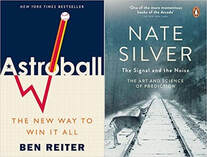
Silver said "Someone will come along and ... figure out how to fuse quantitative and qualitative evaluations of player performance". I'm not sure that Astroball is exactly what Silver had in mind. The fusion is more intuitive than systematic. Maybe that is why the back cover says "combining" hard data and human judgements.
Silver would surely approve of the way Sports Illustrated put "Your 2017 World Series Champs" on the front cover in the middle of 2014. Living and dying by your predictions is central to The Signal and the Noise.
The Signal and the Noise was published a decade after Moneyball. Astroball another half decade after that. It is worth comparing Astroball and Moneyball.
Some of the more memorable passages in Moneyball involved confrontation between the traditional human judgements of the scouts and the decisions based on data analytics. The emphasis is on data analytics going beyond human judgement. In Astroball, the reader is always reminded that there are times where human judgement can go beyond data analytics. That said, the benefit of data analytics from recruitment and in-game strategy is the main theme of the book.
There is another similarity. The author of Moneyball, Michael Lewis, went on to write a bestseller about Israeli psychologists named Daniel Kahneman and Amos Tversky (the former shared the 2002 Nobel Prize in Economics). Ben Reiter introduces the same two individuals to the readers of Astroball. He notes how their work was contemporaneous to the writings of Bill James. No direct comparison is made. I liked that. Just as I liked the book. The exaggerated claims on the front and back covers do not reflect the balanced approach to decision making in the book. The book does an excellent job of navigating the borders of data analytics and human judgement.
 RSS Feed
RSS Feed